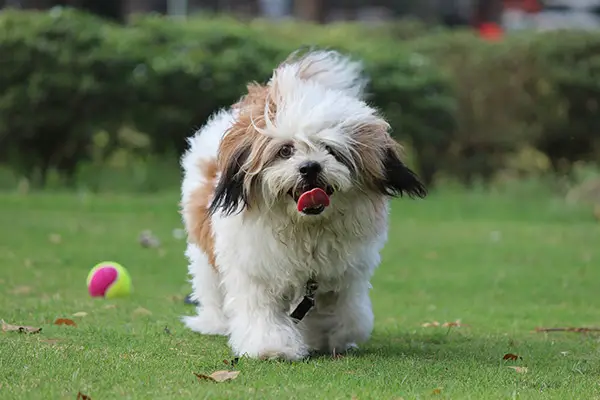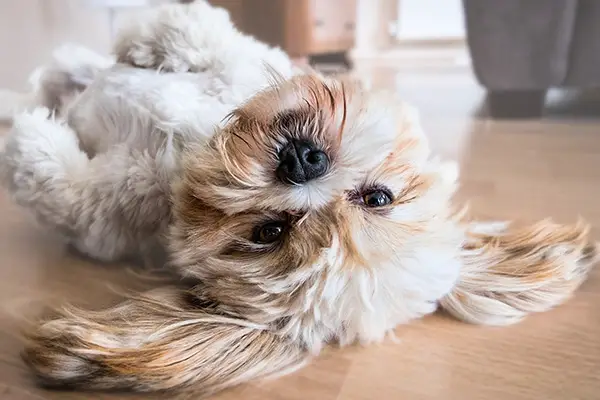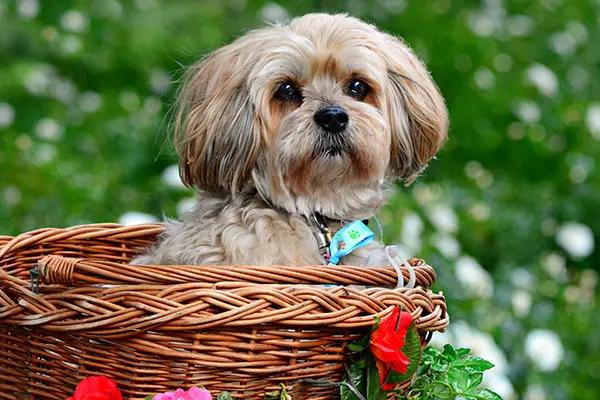Lhasa Apsos are small-sized dogs known for their famous floor-length, flat, and beautiful coat. The coat is then parted in the middle, draping on each side of the body as it comes in colors of black, grizzle, slate, white, and the famous shades of honey. The Lhasa Apso has oval-shaped eyes are mostly hidden behind their long facial hair.
As much as they look so beautiful, the Lhasa Apso is a high maintenance dog breed. They need a lot of attention and grooming, plus, they’re not very obedient. If you want to own one, you would have to do the work. And for the right owner, these beautiful dogs make excellent family pets.

Lhasa Apso Statistics
| Dog Breed Group | Non-Sporting |
| Breed Size | Small |
| Height | 10-11 inches (male); slightly smaller (female) |
| Weight | 12-18 pounds |
| Lifespan | 12-15 years |
Lhasa Apso Ratings
| Energy level | |
| Exercise needs | |
| Requires attention | |
| Playfulness | |
| Trainability | |
| Shedding | |
| Grooming | |
| Friendly with family | |
| Friendly with kids | |
| Friendly with strangers | |
| Friendly with other dogs | |
| Prey Drive |
Lhasa Apso History
Lhasa Apso is an ancient dog breed known to have existed centuries ago. They were first found in Tibet, where they took their name from the holy city of Lhasa.
For centuries, Lhasas were exclusively owned by Tibetan monks and nobles. They served as inside guards and protectors, earning them the name “Abso Seng Kye” or translated to “Bark Lion Sentinel.”
During these times, it was hard to own a Lhasa even though they symbolized good luck. Tibetans also believed that when the owner of a Lhasa dies, his soul enters the dog’s body. They were sacred dogs and can only get out of the country if given as a gift by the Dalai Lama himself.
Some records show that the Dalai Lama gifted Lhasa dogs to the Imperial family of China in the years 1583 to 1908. It was also through the Dalai Lama’s gifts that Lhasa dogs were imported to the US in 1933.
Two years after, in the year 1935, the American Kennel Club recognized the dog breed. The dog’s popularity then started to rise, and they were most especially known because of their beauty.

Lhasa Apso Temperament
Lhasa Apso is a combination of a companion dog and a guard dog. He can be happy, mischievous, and playful, and can also be independent, majestic, and fierce – depending on the people around him.
Although small in size, the Lhasa Apso is not a fragile dog breed. He has a sturdy and robust body, and he takes being a guard dog seriously. He is aloof to strangers but never aggressive, though he is ready to pounce once threatened.
These dogs are affectionate to their family. They love human companionship and are happiest when they are with their humans. They also prefer being indoors than outdoors.
But, they don’t necessarily need attention. They are very independent dogs and can be left alone for long periods. At the same time, they don’t get separation anxiety.
However, Lhasas should never be left alone with children. Like any other small dog breeds, Lhasa Apsos can quickly get irritated when small children bother them too much. They also don’t get along well with other animals though they can if socialized at an early age.
Early socialization will also help them become more well-rounded and control any aggressive side they have. So make sure to get them accustomed to new things, people, and animals from time to time, especially as puppies.
Training may come a little bit challenging because of the dog’s independent nature. It might eat up a lot of your patience, but don’t let them be a reason to hurt them. The trick is to provide firm and consistent leadership.
Lhasa Apso Care Requirements
- Nutrition: The Lhasa Apso, like any other dog breeds, require a high-quality and well-balanced diet. It should contain good sources of protein and fat for muscle support and healthy hair. Great protein sources are whole meats such as chicken, beef, fish, and lamb. As for fats, you can get this from chicken fat. You can also add in some fruits and vegetables for sources of vitamins and fiber. If you’re going to feed you Lhasa dog food, it’s best if it’s grain-free to avoid potential allergies. It also shouldn’t contain fillers and other harmful additives that may cause problems for your dog’s digestion.
- Grooming: Lhasa Apsos have long coats that don’t shed frequently; however, it requires a lot of maintenance. These dogs look good with either a long hair or a puppy cut, depending which you prefer. However, make sure to have it trimmed with an expert to ensure your dog’s safety. Brushing should be done 2-3 times a week or, if possible, daily. This is to prevent mats or tangles from forming, damaging your dog’s hair. Baths should be given regularly as well, at least once a month to maintain their fresh smell. To make things easy for you, you can provide baths every time you take them to a groomer. Ears should be cleaned up regularly as well to prevent ear infection. As for the nails, make sure that it is kept short to avoid discomfort and pain to your dog.
- Exercise: The Lhasa Apso does well indoors, but they are not couch potatoes. They still require a daily amount of exercise to keep them healthy. Usually, this in the form of self-exercise. Running around the apartment all day can be an excellent exercise for them already. You can also take them out on daily brisk walks if you don’t want your apartment to get messy. Mental stimulation is essential, too, so make sure to create exercises that will make them use their cognitive function.
- Health: Though a generally healthy dog breed that has a long lifespan, Lhasas are still prone to various health conditions. Some of the most common are eye infections such as cherry eye, keratoconjunctivitis sicca, and progressive retinal atrophy. Allergies and sebaceous adenitis, which are problems on the skin, are commonly seen too. It’s essential to watch out on what your dog is eating and, of course, to make sure that he doesn’t harm himself. You can also take him to regular check-ups to monitor any changes from his normal condition.
- Lifespan: The life expectancy of Lhasa Apsos is 12-15 years.

Famous Lhasa Apsos
- Ms. Lion: The Lhasa Apso of superhero Firestar from the animated cartoon Spider-Man and his Amazing Friends
- Olivia: Lhasa Apso dog of Glee Star, Jane Lynch
- Meggan: The Lhasa Apso dog of The Voice judge, Gwen Stefani
Fun Facts about Lhasa Apsos
- Lhasa Apso is believed to have originated from Tibet.
- They are an ancient breed that existed since the year 800 AD.
- The name “apso” is said to have derived from the Tibetan word “goat”; because of the Lhasa’s goat-like coat.
- They were originally named “Abso Seng Kye,” which means Bark Lion Sentinel Dog.
- They only left Tibetan as gifts from the Dalai Lama; they were never sold.
- They are sacred; Tibetans believed that the souls of monks who died are reincarnated to the Lhasa Apso.
- Dalai Lamas are the number one fans of Lhasa Apsos.
Check Out Other Non-Sporting Dog Breeds:
American Eskimo Dog, Bichons Frises, Boston Terrier, Bulldog, Chinese Shar-Pei, Chow Chow, Coton de Tulear, Dalmatian, Finnish Spitz, Keeshonden, Lowchen, Norwegian Lundehund, Schipperkes, Shiba Inu, Tibetan Spaniel, Tibetan Terrier, Xoloitzcuintli
